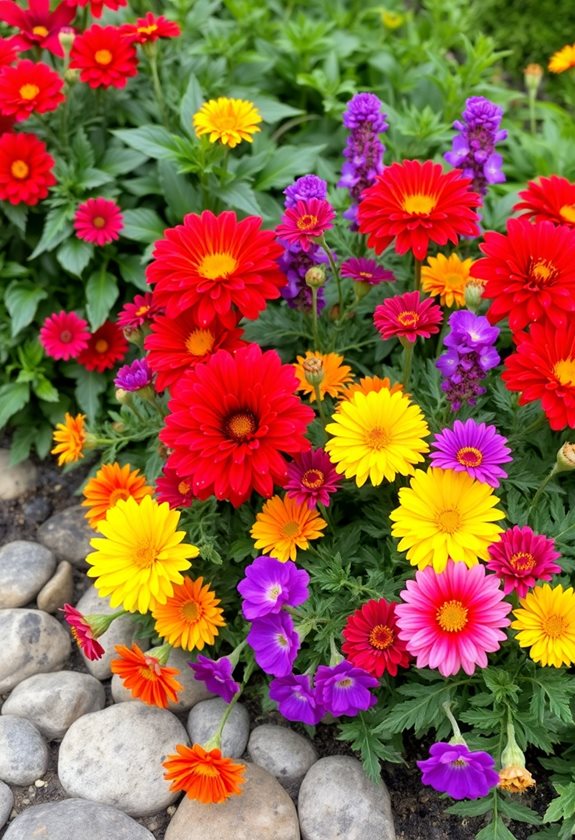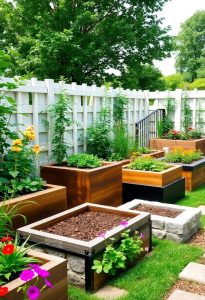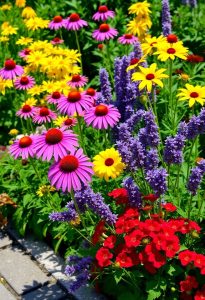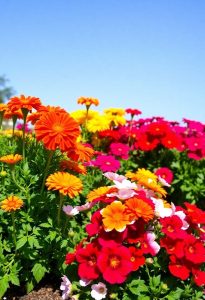Mixing colors in your flower bed designs can be a fun way to express your personality! Start by choosing a color palette—how about three or four key colors? Use complementary colors, like fiery reds with cool greens, for dramatic flair, or go for harmonious vibes with analogous colors such as soft yellows, oranges, and golds. Don’t forget neutrals to balance things out! And let’s be honest, a little planning goes a long way in creating your dream garden! Want to know more tips?
Design Highlights
- Assess existing colors in your garden to create a cohesive flower bed design.
- Limit your color palette to three or four complementary or analogous colors for visual impact.
- Incorporate various textures and heights to add depth and interest to flower arrangements.
- Use bold colors strategically to create focal points that draw the eye within the garden.
- Consider seasonal blooms to maintain color harmony and interest throughout the year.
Understanding Color Theory in Gardening
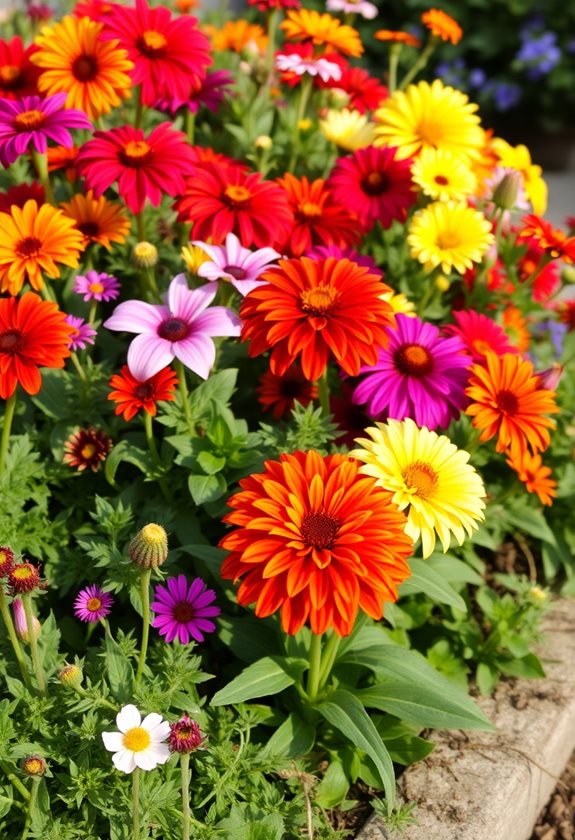
When you think about planting a flower bed, have you ever stopped to contemplate how colors can transform your garden into a breathtaking masterpiece? Understanding color theory is your first step! Consider:
Contemplate the power of color in your flower bed; it can turn an ordinary garden into an extraordinary masterpiece!
- Warm Colors: Reds, yellows, and oranges bring energy and excitement.
- Cool Colors: Blues and purples create calm and serenity.
- Neutrals: Whites and greens can balance and highlight other colors.
Mixing these shades can evoke feelings and set moods—like a vibrant sunset or a tranquil morning. Additionally, incorporating colorful flower beds can enhance the beauty of your garden while attracting essential pollinators. So, why not experiment? You might just discover a colorful combination that makes your garden sing with joy! Happy gardening!
Choosing a Color Palette
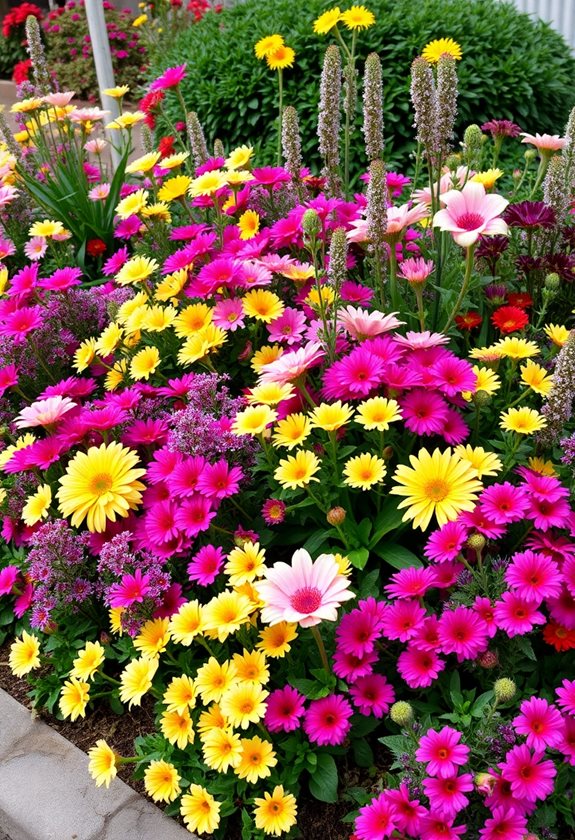
Choosing a color palette for your flower bed can feel like picking toppings for your favorite pizza—there are so many delicious options, and it’s all about finding the right combination! To master this, consider these steps:
- Assess your space: What colors already exist?
- Select a theme: Classic, vibrant, or serene?
- Choose a few key colors: Limit it to three or four.
- Experiment with textures: Mix blooms, foliage, and heights for depth! Additionally, incorporating unique color combinations can enhance the visual appeal of your garden.
Complementary Colors for Bold Statements
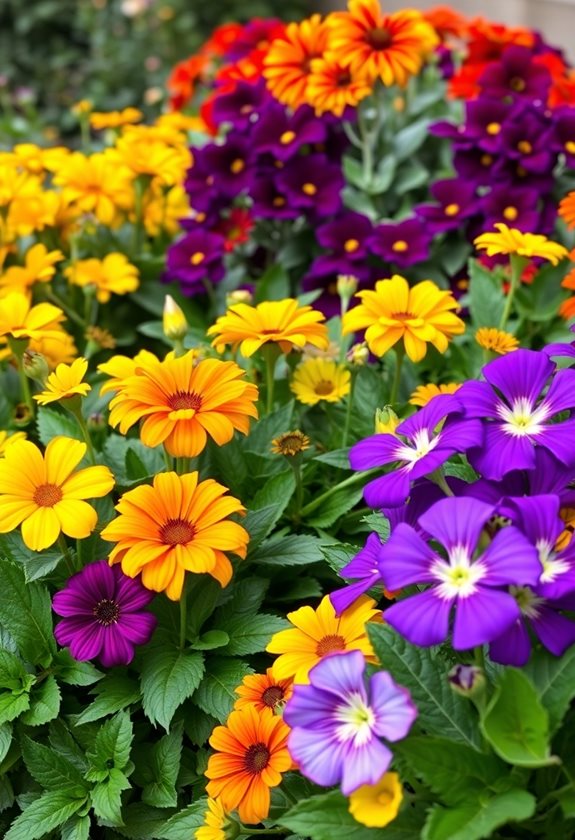
Using complementary colors in your flower bed can turn an ordinary garden into a vibrant masterpiece! Imagine fiery reds against cool greens or bright yellows paired with deep purples—what a show! To create this stunning effect, choose flowers like orange marigolds next to blue delphiniums. This contrast not only draws the eye but energizes your space. Don’t forget to balance these bold statements with some neutral foliage to avoid overwhelming the senses. Ready to take the plunge? Immerse yourself in this colorful journey and watch your garden transform into a dazzling display that’ll leave everyone in awe! Isn’t that what gardening’s all about? Additionally, incorporating best flower selections ensures a diverse palette that enhances the overall beauty of your garden.
Analogous Colors for a Harmonious Look
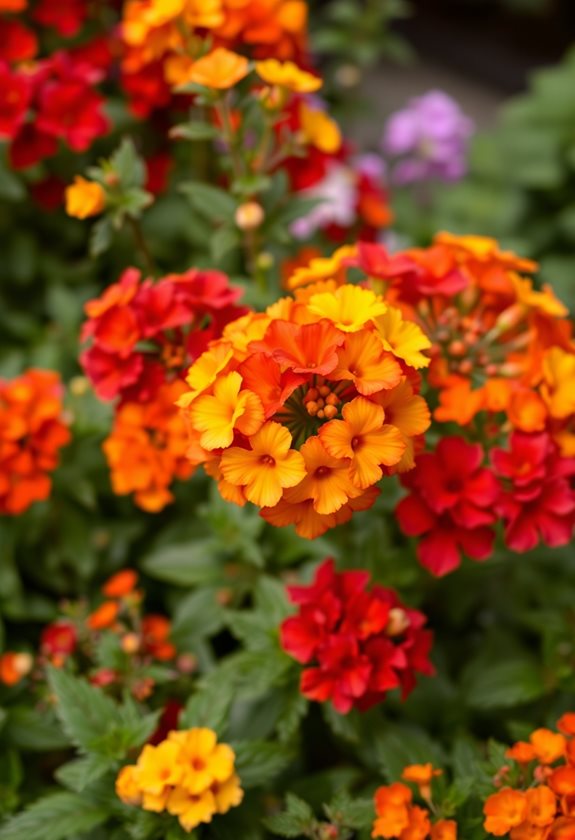
Imagine stepping into a garden where colors flow seamlessly into one another, creating a peaceful oasis that feels just right. Using analogous colors—those next to each other on the color wheel—can transform your flower beds beautifully. Here’s how to master this technique:
- Choose a base color, like soft yellow.
- Pick adjacent shades, such as orange and gold.
- Mix in different textures and heights for depth.
- Consider seasonal blooms to maintain harmony year-round.
Incorporating vibrant flower bed designs can elevate the overall aesthetic of your garden. With these tips, you’ll create a stunning, cohesive look that invites tranquility. Ready to plunge in? Your garden deserves this harmonious touch!
Incorporating Neutrals for Balance
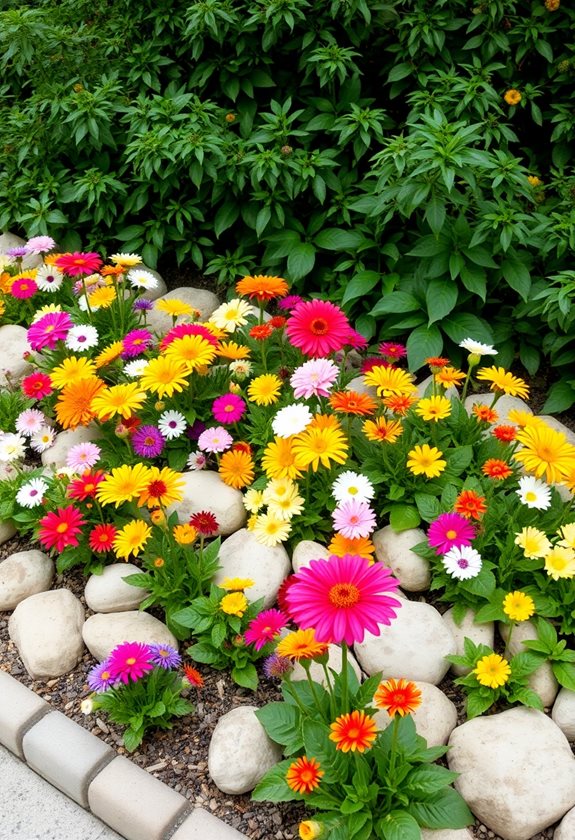
While you might think that bold colors steal the show in a garden, incorporating neutrals can actually bring a revitalizing balance to your flower bed designs. Neutrals, like whites, creams, and soft grays, act as a canvas that allows vibrant blooms to pop! Imagine a sea of bright reds and yellows softened by gentle whites—stunning, right?
To master this, try:
- Mixing light shades with darker hues for contrast.
- Using neutral foliage to frame colorful flowers.
Additionally, consider that material durability and weather resistance can enhance your flower bed’s longevity, allowing those colors to shine year after year. Don’t shy away from using neutrals; they’re your garden’s unsung heroes! So, are you ready to let those colors shine? Let’s get mixing!
Seasonal Flower Color Selection
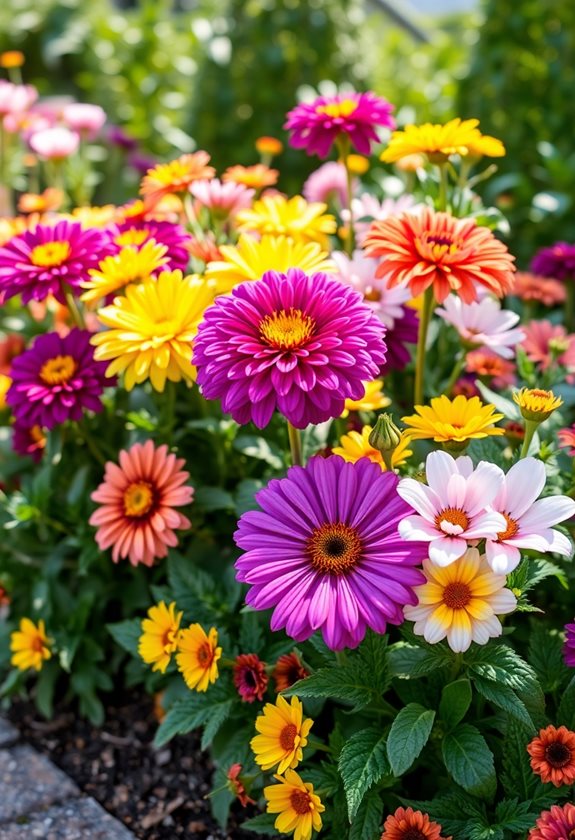
When you’re planning your flower bed, have you ever thought about how the seasons influence your color choices? Each season offers a unique palette that can elevate your garden’s beauty. Here’s how to select colors to match the seasons:
- Spring: Embrace pastels like soft pinks and light yellows.
- Summer: Go bold with vibrant reds, oranges, and purples.
- Fall: Opt for warm hues like deep oranges, burgundies, and golds.
- Winter: Incorporate evergreen and white blooms for contrast.
Mixing seasonal colors not only enhances visual appeal, but it also creates a delightful journey through your flower bed! Additionally, consider incorporating low-maintenance plants that thrive in your climate for a hassle-free experience.
Textures and Shapes in Color Mixing
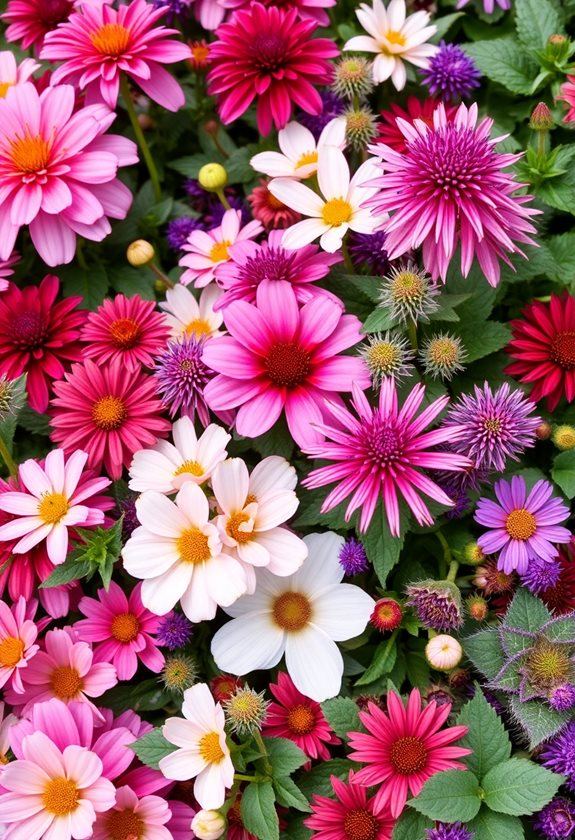
Choosing the right colors for your flower bed is just the beginning; it’s also about how those colors interact through textures and shapes. Want to create a stunning garden? Consider mixing soft, feathery plants like astilbe with bold, spiky ones like delphinium. This contrast not only highlights your colors but also adds depth!
- Textures: Smooth petals versus rough leaves can create visual interest.
- Shapes: Round blooms next to tall, slender stalks can guide the eye.
Incorporating best flowering plants into your design can elevate the overall aesthetic. Experiment and see what works! Remember, gardening’s a journey; don’t fret over mistakes—embrace them! After all, who doesn’t love a little chaos in nature?
Creating Focal Points With Color
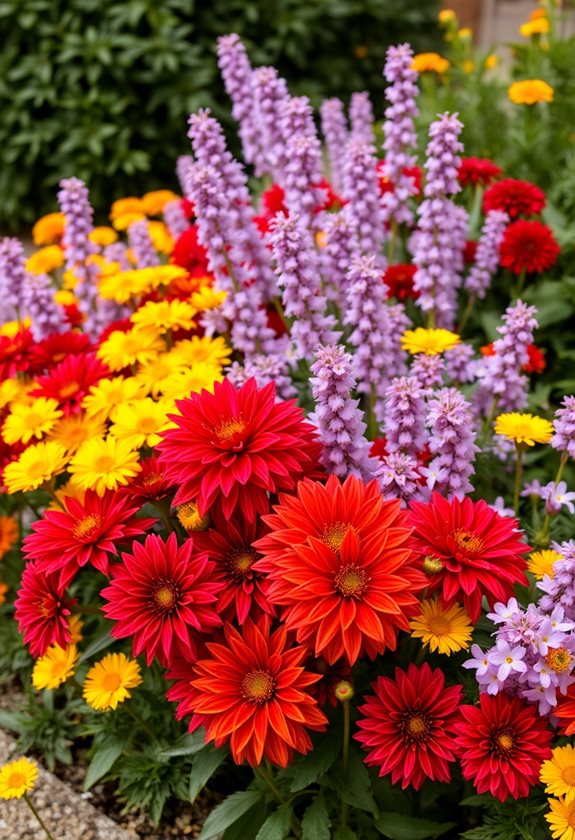
Creating a stunning focal point in your flower bed can transform an ordinary garden into a mesmerizing masterpiece! To master this art, consider these key strategies:
- Bold Colors: Use vibrant blooms to draw the eye.
- Contrasting Textures: Mix smooth petals with rough foliage for depth.
- Strategic Placement: Position focal plants at eye level or in clusters.
- Seasonal Variation: Choose flowers that bloom at different times for year-round interest.
Incorporating vibrant plants into your design can enhance the visual appeal and ensure your garden remains colorful throughout the seasons. When you create that perfect focal point, it feels like magic! What’s your favorite color combo? Let your creativity shine, and your garden will thank you!
Maintenance Tips for Colorful Flower Beds
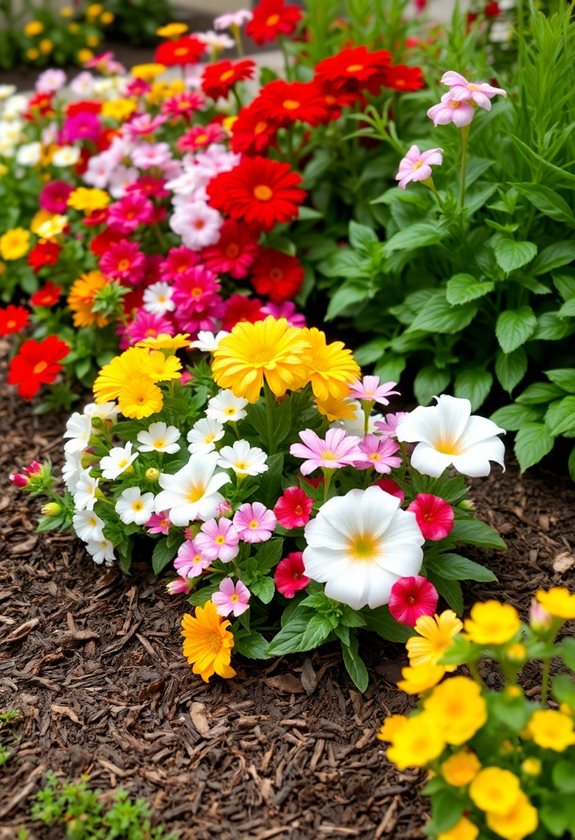
Your beautiful flower bed deserves just as much love and attention after you’ve crafted that stunning focal point! Regular maintenance keeps your colors vibrant and healthy. Start by deadheading spent blooms; it encourages more flowers and keeps your bed looking fresh. Water deeply, but less frequently—roots need to breathe! Mulching helps retain moisture and suppress weeds. Don’t forget to fertilize; a balanced fertilizer every few weeks can make a world of difference. And, seriously, watch out for pests! Catch them early to avoid a garden disaster. Remember, a colorful flower bed is a happy flower bed—let your passion shine through! Additionally, incorporating vibrant flower bed tips can enhance your garden’s overall aesthetic and health.
Frequently Asked Questions
What Flowers Attract Pollinators While Mixing Colors?
If you want to attract pollinators while adding vibrant colors to your garden, consider planting sunflowers, lavender, and zinnias! These flowers not only look amazing together, but they also draw bees and butterflies. Imagine seeing those fluttering friends buzzing around your blooms! Mixing colors like bright yellow sunflowers with soft purple lavender creates a stunning contrast. Plus, it’s a joy to watch nature come alive in your backyard. Isn’t gardening just the best?
How Do Weather Conditions Affect Flower Color Vibrancy?
Weather can really make or break your flowers’ color vibrancy! Think about it:
- Sunlight: More sun can intensify colors, while too much heat might fade them.
- Rain: A good soak can boost brightness, but too much can drown their beauty.
- Temperature changes: Cool nights can enhance color, while scorching days might drain it.
Can I Mix Annuals and Perennials in Color Schemes?
Imagine your garden as a vibrant tapestry, weaving together stories of annuals and perennials. Yes, you can absolutely mix them! Annuals bring that instant burst of color, while perennials offer a reliable backdrop year after year. Think of it like friends at a party, each adding their unique flair. Just remember to take into account their sunlight and water needs. Have fun experimenting! Which colors will dance together in your garden this season?
What Are Some Color Combinations to Avoid?
When you’re planning your garden, some color combos just don’t work! Avoid mixing clashing colors like bright orange with hot pink—it can be a bit of an eyesore! Instead, consider more harmonious pairings like soft blues and whites. Trust me, your garden will thank you! And remember, if you’re unsure, go for nature’s favorites, like yellows with purples. What’s your favorite combo? Let’s make your garden a masterpiece!
How Often Should I Change My Flower Bed Colors?
You should change your flower bed colors at least once a year, but don’t be afraid to mix it up more often! Think about seasonal blooms and how they can refresh your space. For example, you might go for bright yellows and oranges in summer, then switch to rich reds and purples in fall. It’s like giving your garden a wardrobe makeover—who doesn’t love a fresh look? Keep experimenting and enjoy the process!

